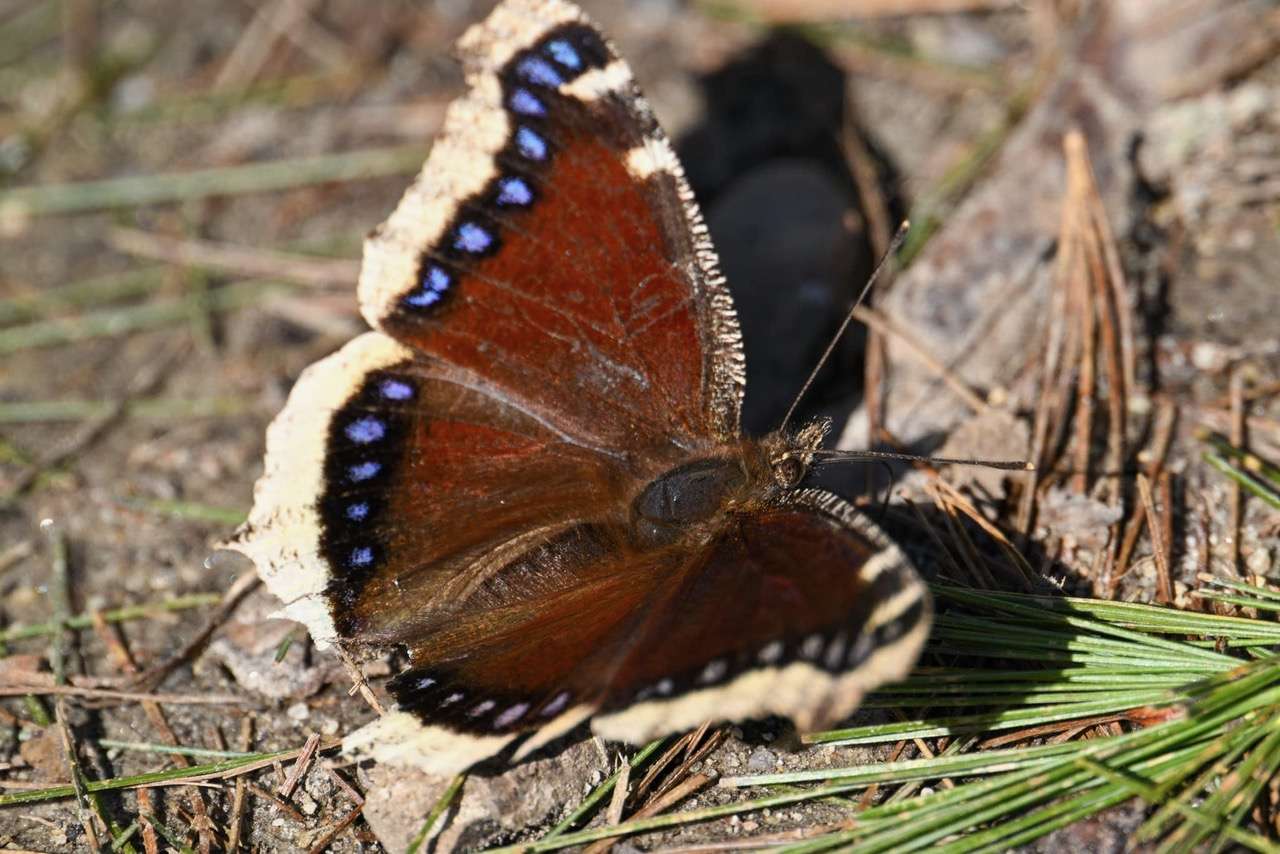Out In The Woods
- April 19th 2024
- Out in the Woods

A mourning cloak butterfly feeds on pine pitch
Photo: Susan Pieter
Earliest Butterfly Is Also the Longest Living
By Kevin McKeon, Director, Mousam Way Land Trust
The first butterfly you’ll often see along Sanford’s trails in very early spring, with snow on the ground and ice on some ponds, is the mourning cloak. It has awakened from its winter’s hibernation under loose tree bark or other small, sheltered cavity. With insects, this hibernation is called torpor. Mourning cloaks often rest on dark tree bark where they are camouflaged from predators and can bask in direct sunlight, opening their dark-colored wings toward the sun to absorb heat and increasing their body temperature to enable flight. This is important to butterflies living in cold, mountainous areas, especially those that are active in early spring like the mourning cloak. This remarkable butterfly was designated Montana’s official state butterfly in 2001.
The coloration of the mourning cloak’s wings not only offers heat gathering abilities, but also equips the mourning cloak with a rare survival technique; if a hungry predator happens to bother this enterprising guy, it’ll fall to the ground, blending quite well among the dried leaves, and play dead! Watch it here.
Adults feed on tree sap, rotting fruit, dung, mud, and only occasionally on flower nectar. They can often be found at the holes in trees made by the yellow-bellied sapsucker. These parallel rows of small holes ooze sap and will also attract flies, bees, and other butterflies. Mourning cloaks are often found at the edges of spring-melt puddles, obtaining minerals from the mud.
Mourning cloaks live all over the world and are quite common in North America; they are, however, protected in Switzerland and Austria. Find them near poplar, elm, and willow, their host trees. In mating season, females seek these leaves upon which to lay eggs. The leaves will serve as sustenance for the caterpillars. The eggs hatch in 10 to 14 days and the very hungry caterpillars will not only chomp away on the leaves, but on each other. So, it’s the fortunate ones who hatch early that survive. Those that do so will gather and forage as a group, finding safety in numbers and finding a bit of protection from their spiny skins. When fully grown, they leave in search of a place to make their chrysalises. The caterpillar stage lasts for 14 to 18 days, the chrysalis stage for eight to 15 days. As they grow, each instar (as the caterpillars are called) will shed its skin five times. The fifth instar will then cocoon into a gray/tan chrysalis on a grass stem. Two weeks later, the metamorphosis completes, and the adult butterfly emerges.
The mourning cloak butterfly faces many predators throughout its development. Their eggs are eaten by beetles, ants, wasps, mites, and other insects. Adults are eaten by praying mantises, assassin bugs, dragonflies, and vertebrate predators such as birds, reptiles, amphibians, and mammals. Because they are common and eaten by many other creatures, mourning cloaks are an important addition to the lower trophic food chain of an ecosystem, as are all insects.
The mourning cloak gets its name from its color resemblance to an archaic, traditional cloak worn when someone was in mourning. They are fairly large at about four inches, and with a lifespan of a year, are the longest living of all North American butterflies. During adverse environmental conditions such as high heat or very dry weather, mourning cloaks will sometimes “aestivate,” a summertime dormancy state, similar to hibernation. And during times of low food availability, they also enter a “diapause” dormancy state during which development is stopped. These adaptations have evolved over time to help ensure the species’ survival. Emerging from dormancy in early autumn, when food and temperature are more favorable, they’ll continue their development towards maturity and the now healthy mourning cloak will then find a cozy overwintering home.
So, come take a stroll among Sanford’s many beautiful trails, and the deeper woods trails of Mousam Way Land Trust’s offerings and look for the mourning cloak butterfly around the sunny tree lines and forest openings.






